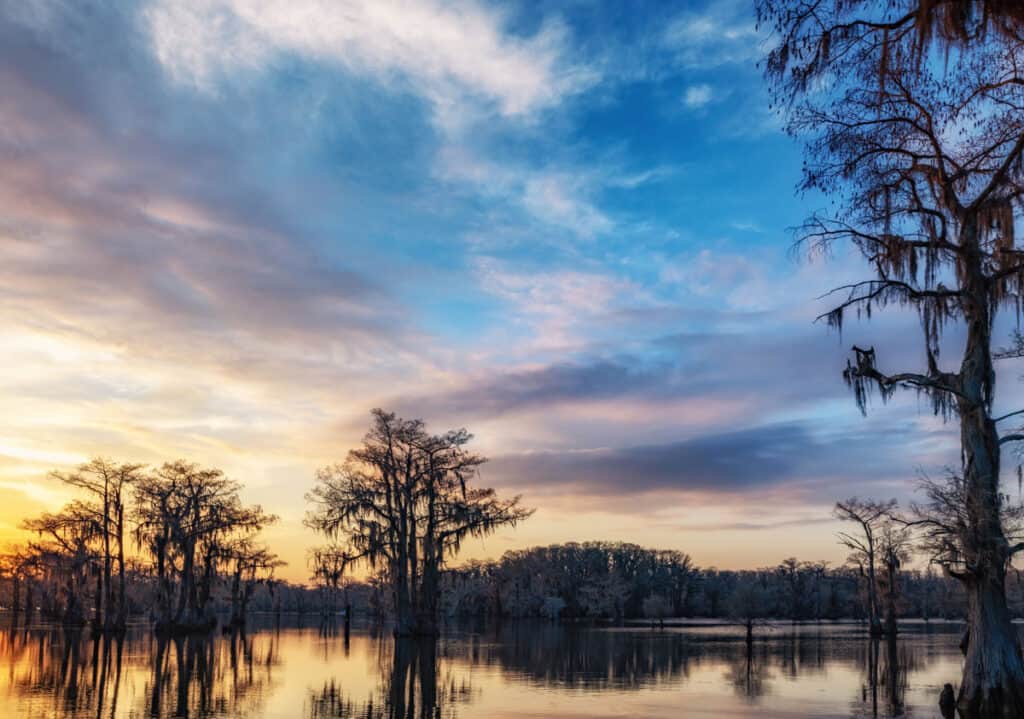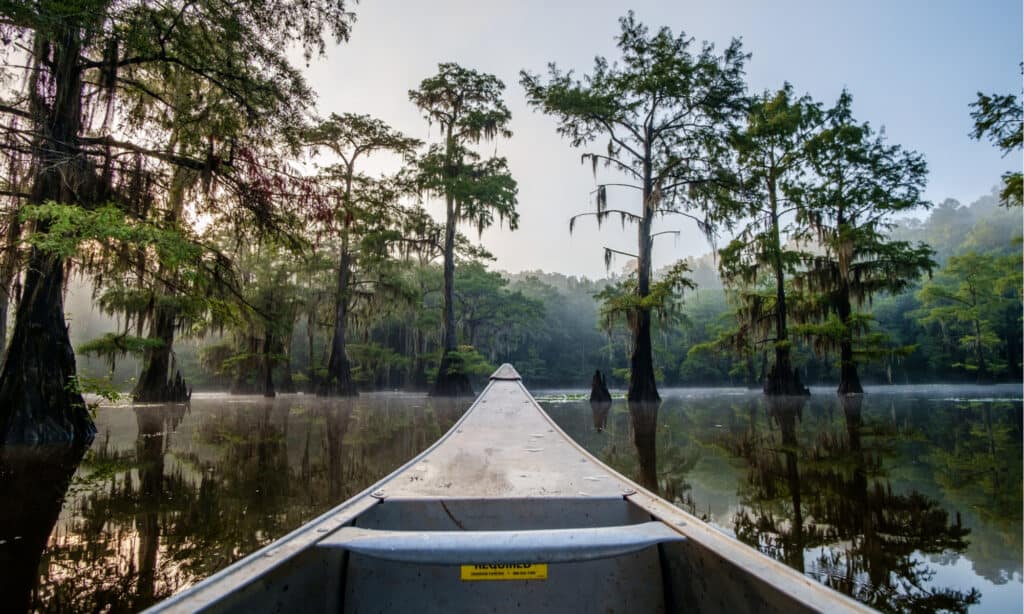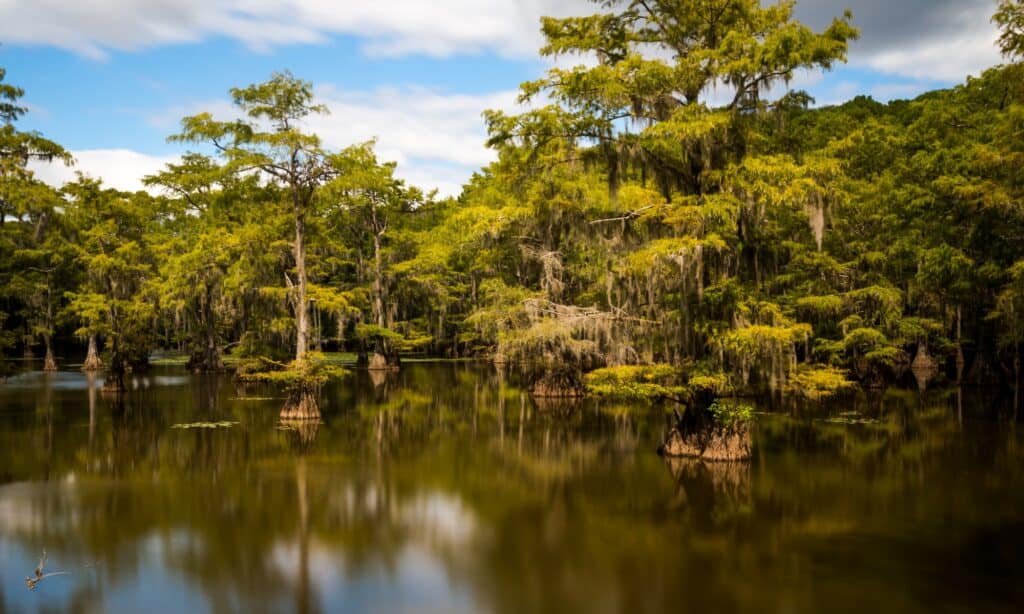Many people think of a lake as a simple body of water, but Caddo Lake in Texas is almost like another world all on its own. There are amazing views, tons of waterways that intersect with the lake, and an abundance of natural beauty. Caddo Lake has also been the location of hundreds of supposed Bigfoot sightings!
It can be hard to tell how deep a lake is, as depth can vary from point to point. Also, it’s not a measurement that an individual can easily make at any specific point. If you want to learn more about Caddo Lake and its dimensions, keep reading!
Background Information on Caddo Lake

Legends say Caddo Lake formed as the result of an earthquake that a Caddo tribe chief caused when he refused to obey the Great Spirit.
©iStock.com/westtexasfish
Caddo Lake is named for the Caddo Native Americans who settled in this area in the 18th and 19th centuries. The United States government purchased the lake from this Native American tribe in 1835.
According to Caddo legend, the lake formed as the result of an earthquake that one of their chiefs caused when he refused to obey the Great Spirit. The most common modern theory is that the lake formed naturally behind a log jam within the Red River. The national government destroyed this jam, known as the Red River Raft, in 1874.
Caddo Lake had the distinction of being the only natural lake in the state of Texas until 1914. At this point, it was artificially dammed for flood control purposes. The dam was replaced in 1971.
The lake is used for not only wildlife preservation and recreation, but also for water conservation. In 1993, environmentalists had this lake recognized as an international wetlands site in order to block the construction of a barge canal that would have gone through the lake.
On average, the lake spans approximately 26,000 acres of land. This can vary with rainfall, meaning that the range can be anywhere between 25,400 and 33,000 acres.
How Deep Is Caddo Lake?

The average depth of Caddo Lake is about 8 to 10 feet.
©Daniel Mullins/Shutterstock.com
Caddo Lake is about 8 to 10 feet deep on average. However, the deep water in the bayou can be up to about 20 feet deep. Given how vast the lake is in terms of land area, it is actually surprisingly shallow. Most lakes are about 30 to 35 feet deep, making this lake significantly less deep than the average.
For this reason, in addition to the vast diversity of fish species present, people see Caddo Lake as a good fishing lake. There are areas of the lake that are deep enough to protect the fish during the cold months, yet the shallowness and slow-moving current make it a popular environment for boaters and anglers who want a relaxing trip on the water.
Where Is Caddo Lake?

You can find Caddo Lake in Marion and Harrison Counties in Texas, and also the Caddo Parish in Louisiana.
©Victoria Ditkovsky/Shutterstock.com
Caddo Lake is located not only in Texas, but Louisiana as well. Specifically, the lake’s home is in Marion and Harrison Counties of Texas and Caddo Parish of Louisiana.
The watersheds of Big Cypress Bayou, Little Cypress Bayou, Jeems Bayou, and Black Cypress Bayou all feed into Caddo Lake. The drainage area above the dam of Caddo Lake includes about 2,700 square miles of space.
Even though the water of Caddo Lake is public, the shores have private owners. Specifically, the Cypress Valley Navigation District maintains the boat channels. Texas Park and Wildlife owns 8,000 acres of the lake and operates Caddo Lake State Park as well. The dam is owned and operated by Caddo Lake Levee District.
Where is Caddo Lake Located on a Map?
Caddo Lake is located in the northeastern part of Texas, near the border with Louisiana. It covers an area of approximately 25,400 acres and includes parts of Marion County, Harrison County, and Caddo Parish in Louisiana. The lake is situated within the Cypress Basin and forms a natural boundary between Texas and Louisiana. To locate it on a map, one can search for Jefferson or Marshall areas in Texas as they are nearby cities to the lake’s location.
Caddo Lake State Park
A good amount of the mystique surrounding Caddo Lake relates to the state park that rests on the banks of the Big Cypress Bayou. The watershed of the lake is not just a simple mass of water in a simple shape, as many man-made lakes are. It includes slow-moving bayous, backwaters, and wetlands, as well as cypress swamp.
Habitats in Caddo Lake State Park
Caddo Lake State Park is located on the Texas side of the lake. There are three major habitats within this park:
- Bottomlands: Closest to the body of water is this habitat, home to imposing bald cypress, water tupelo, water oak, sugarberry, and sweetgum trees. Many birds and small mammals hide and nest in these areas, including wood ducks.
- Mesic slopes: This is where the land transitions from swamp to temperate forest, full of pine and oak trees. Here, you’ll see animals more typical of an inland forest, including gray squirrels.
- Uplands: The largest forested area in the park consists of this habitat. You’ll see pine and oak trees, as well as berry-producing shrubs like American beautyberry and holly. This area is home to Virginia opossums, raccoons, whitetail deer, and other typical forest animals.
Caddo Lake and its watershed are home to an astonishing number of wildlife species. The largest variety of native aquatic wildlife in Texas is in this watershed. You can also find many bird species, as the park is located within the Central Flyway, which is within the migratory path for many birds.
This dense swamp is a highly desirable environment for many people who want to paddle through the water and canoes and kayaks. It’s important to follow the marked waterways, as one can easily get lost in this maze otherwise. There are 10 trails for these small watercraft, including Cathedral Trail, Turtle Shell Trail, and Old Folks’ Playground.
There are many sightseeing boat tours, fishing tours, and other types of guides that can teach visitors all about the area. In addition to the water trails, there are many surrounding hiking trails and campsites.
Animals In and Around Caddo Lake

American alligators live in the area around Caddo Lake.
©iStock.com/Cindy Larson
Anyone who observes the wildlife in and around Caddo Lake will definitely notice the astonishing diversity. In the lake alone, there are over 90 species of fish including largemouth bass, white bass, and crappie.
In addition to this, there are around 60 reptiles, including the five-lined skink, American alligator, Eastern newt, and alligator snapping turtle. There are also 30 amphibians and 55 mammals that live in the habitats surrounding the lake.
Approximately 200 bird species fly through the area as well. Birdwatchers will enjoy seeing the indigo bunting, great blue heron, pileated woodpecker, and prothonotary warbler.
The photo featured at the top of this post is © Victoria Ditkovsky/Shutterstock.com
Thank you for reading! Have some feedback for us? Contact the AZ Animals editorial team.






